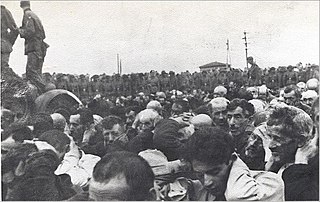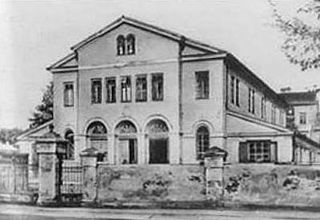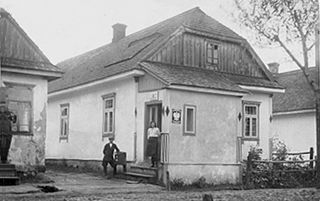 W
WGhettos were established by Nazi Germany in hundreds of locations across occupied Poland after the German invasion of Poland. Most ghettos were established between October 1939 and July 1942 in order to confine and segregate Poland's Jewish population of about 3.5 million for the purpose of persecution, terror, and exploitation. In smaller towns, ghettos often served as staging points for Jewish slave-labor and mass deportation actions, while in the urban centers they resembled walled-off prison-islands described by some historians as little more than instruments of "slow, passive murder", with dead bodies littering the streets.
 W
WThe Będzin Ghetto was a World War II ghetto set up by Nazi Germany for the Polish Jews in the town of Będzin in occupied south-western Poland. The formation of the 'Jewish Quarter' was pronounced by the German authorities in July 1940. Over 20,000 local Jews from Będzin, along with additional 10,000 Jews expelled from neighbouring communities, were forced to subsist there until the end of the Ghetto history during the Holocaust. Most of the able-bodied poor were forced to work in German military factories before being transported aboard Holocaust trains to the nearby concentration camp at Auschwitz where they were exterminated. The last major deportation of the ghetto inmates by the German SS – men, women and children – between 1 and 3 August 1943 was marked by the ghetto uprising by members of the Jewish Combat Organization.
 W
WThe Białystok Ghetto was a Nazi ghetto set up by the German SS between July 26 and early August 1941 in the newly formed District of Bialystok within occupied Poland. About 50,000 Jews from the vicinity of Białystok and the surrounding region were confined into a small area of the city, which was turned into the district's capital. The ghetto was split in two by the Biała River running through it. Most inmates were put to work in the slave-labor enterprises for the German war effort, primarily in large textile, shoe and chemical companies operating inside and outside its boundaries. The ghetto was liquidated in November 1943. Its inhabitants were transported in Holocaust trains to the Majdanek concentration camp and Treblinka extermination camps. Only a few hundred survived the war, either by hiding in the Polish sector of the city, escape following the Bialystok Ghetto Uprising, or by surviving the camps.
 W
WThe Brześć Ghetto or the Ghetto in Brest on the Bug, also: Brześć nad Bugiem Ghetto, and Brest-Litovsk Ghetto was a Nazi ghetto created in occupied Western Belarus in December 1941, six months after the German troops had invaded the Soviet Union in June 1941. Less than a year after the creation of the ghetto, around October 15–18, 1942, most of approximately 20,000 Jewish inhabitants of Brest (Brześć) were murdered; over 5,000 were executed locally at the Brest Fortress on the orders of Karl Eberhard Schöngarth; the rest in the secluded forest of the Bronna Góra extermination site, sent there aboard Holocaust trains under the guise of 'resettlement'.
 W
WBrzesko Ghetto was a Nazi ghetto during World War II in occupied Poland. The ghetto was created by the Third Reich in 1941 in the Polish town of Brzesko located in the Kraków District about 40 miles from Kraków. The ghetto was open when it was first created. In 1942, walls were put up and the ghetto became a closed ghetto. An estimated 4,000 Jewish people lived there but another 2,000 moved there by 1942, many arriving from Kraków and the surrounding area. The Jewish people living within Brzesko were sent to the Bełżec extermination camp and Auschwitz extermination camp. After the exterminations, the camp was closed end of 1942.
 W
WThe Częstochowa Ghetto was a World War II ghetto set up by Nazi Germany for the purpose of persecution and exploitation of local Jews in the city of Częstochowa during the German occupation of Poland. The approximate number of people confined to the ghetto was around 40,000 at the beginning and in late 1942 at its peak, immediately before mass deportations, 48,000. Most ghetto inmates were delivered by the Holocaust trains to their deaths at the Treblinka extermination camp. In June 1943, the remaining ghetto inhabitants launched the Częstochowa Ghetto uprising, which was extinguished by the SS after a few days of fighting.
 W
WFrysztak Ghetto was created in the Polish shtetl of Frysztak during World War II by Nazi Germany and existed until 18 August 1942, when it was liquidated.
 W
WThe Gorlice Ghetto was established in the year 1940 after German occupation of the Polish city began on September 7, 1939. As one of many ghettos created by Nazi Germany in the General Government, its establishment meant further persecution and violence against the nearly 3,400 Jewish citizens that were settled in the area. As German forces quickly seized hundreds of the young, able men of Gorlice in order to use them for forced labor, many Jews began hiding for their lives as their businesses were taken and the rapid spread of disease plagued the city. The ghetto was officially dissolved on September 14, 1942, and carried with its downfall the transportation of hundreds of Jews to the concentration camp located in Bełżec.
 W
WThe Grodno Ghetto was a Nazi ghetto established in November 1941 by Nazi Germany in the city of Grodno for the purpose of persecution and exploitation of Jews in Western Belarus.
 W
WThe Jewish Ghetto Police or Jewish Police Service, also called the Jewish Police by Jews, were auxiliary police units organized within the Nazi ghettos by local Judenrat.
 W
WThe Kielce Ghetto was a Jewish World War II ghetto created in 1941 by the Schutzstaffel (SS) in the Polish city of Kielce in the south-western region of the Second Polish Republic, occupied by German forces from 4 September 1939. Before the Nazi invasion of Poland in 1939, Kielce was the capital of the Kielce Voivodeship. The Germans incorporated the city into Distrikt Radom of the semi-colonial General Government territory. The liquidation of the ghetto took place in August 1942, with over 21,000 victims deported to their deaths at the Treblinka extermination camp, and several thousands more shot, face-to-face.
 W
WThe Kraków Ghetto was one of five major metropolitan Nazi ghettos created by Germany in the new General Government territory during the German occupation of Poland in World War II. It was established for the purpose of exploitation, terror, and persecution of local Polish Jews. The ghetto was later used as a staging area for separating the "able workers" from those to be deported to extermination camps in Operation Reinhard. The Ghetto was liquidated between June 1942 and March 1943, with most of its inhabitants deported to the Belzec extermination camp as well as to Płaszów slave-labor camp, and Auschwitz concentration camp, 60 kilometres (37 mi) rail distance.
 W
WŁachwa Ghetto was a Nazi ghetto in Western Belarus during World War II. Located in Lakhva, Belarus), the ghetto was created with the aim of persecution and exploitation of the local Jews. The ghetto existed until September 1942. It was the location of one of the first Jewish ghetto uprisings.
 W
WThe Łomża Ghetto was a Nazi ghetto created by on 12 August 1941 in Łomża, Poland; for the purpose of persecution of Polish Jews. Two months after Operation Barbarossa, the invasion of the Soviet Union, the Jews were ordered to move there in a single day, resulting in panic at the main entry on Senatorska Street adjacent to the Old Market. The number of Jewish men, women, and children forced into the ghetto ranged from 10,000 to 18,000. The survivors of the anti-Jewish Jedwabne pogrom, Stawiski, Wizna, and Rutki-Kossaki as well as refugees from other locales were interned in the ghetto. Often, six families were housed there in a single room. The Ghetto was liquidated a year-and-a-half later on 1 November 1942, when all prisoners were transported aboard Holocaust trains to Auschwitz for extermination.
 W
WThe Lutsk Ghetto was a Nazi ghetto established in 1941 by the SS in Lutsk, Western Ukraine, during World War II. In the interwar period, the city was known as Łuck and was part of the Wołyń Voivodeship (1921–1939) in the Second Polish Republic.
 W
WThe Lwów Ghetto was a Nazi ghetto in the city of Lwów in the territory of Nazi-administered General Government in German-occupied Poland.
 W
WMarcinkonys or Marcinkańce Ghetto was a small Jewish ghetto established during the Holocaust in Marcinkonys. It existed from around November 1941 to November 1942 and housed 300 to 400 Jews.
 W
WThe Mińsk Mazowiecki Ghetto or the Mińsk Ghetto was a World War II ghetto set up by Nazi Germany in occupied Poland. Some 7,000 Polish Jews were imprisoned there from all neighbouring settlements for the purpose of persecution and exploitation. Two years later, beginning 21 August 1942 during the most deadly phase of the Holocaust in occupied Poland, they were rounded up – men, women and children – and deported to Treblinka extermination camp aboard Holocaust trains. In the process of Ghetto liquidation, some 1,300 Jews were summarily executed by the SS in the streets of Mińsk Mazowiecki.
 W
WThe Nowy Sącz Ghetto known in German as Ghetto von Neu-Sandez and in Yiddish as צאנז or נײ-סאנץ was a World War II ghetto set up by Nazi Germany for the purpose of persecution and exploitation of Polish Jews in the city of Nowy Sącz pronounced [ˈnɔvɨ ˈsɔnt͡ʂ] during the occupation of Poland (1939–45).
 W
WOlkusz Ghetto was a ghetto for the Jewish population that existed in Olkusz during the German occupation of Poland.
 W
WThe Opatów Ghetto was a World War II ghetto set up by Nazi Germany for the purpose of persecution and exploitation of local Jews in the town of Opatów during the German occupation of Poland. The approximate number of Jewish people confined to the ghetto was about ten thousand, including a group of expelees from the Czech Republic and Austria. Beginning in January 1942 the SS conducted mass shooting actions at the Jewish cemetery in Opatów where the bodies of the Ghetto victims were also buried by the hundreds.
 W
WThe Pińsk Ghetto was a Nazi ghetto created by Nazi Germany for the confinement of Jews living in the city of Pińsk, Western Belarus. Pińsk, located in eastern Poland, was occupied by the Red Army in 1939 and incorporated into the Byelorussian SSR. The city was captured by the Wehrmacht in Operation Barbarossa in July 1941; it was incorporated into the German Reichskommissariat Ukraine in autumn of 1941.
 W
WThe Piotrków Trybunalski Ghetto was created in Piotrków Trybunalski on October 8, 1939, shortly after the 1939 German Invasion of Poland in World War II. It was the first Nazi ghetto in occupied Europe. founded on October 8, 1939 The town was occupied by the Wehrmacht on September 5, 1939. Piotrków was made into a county seat (Kreis) of the newly created Łódź District of the German territory of Reichsgau Wartheland. The ghetto was put under the command of Hans Drexler, an appointed Nazi Oberbürgermeister who also created the Ghetto. In total, some 16,500to up to 28,000 Jews went through the Piotrków Ghetto which was liquidated beginning 14 October 1942 in four days of deportations to Treblinka and Majdanek aboard overcrowded Holocaust trains.
 W
WRadom Ghetto was a Nazi ghetto set up in March 1941 in the city of Radom during occupation of Poland, for the purpose of persecution and exploitation of Polish Jews. It was closed off from the outside officially in April 1941. A year and a half later, the liquidation of the ghetto began in August 1942, and ended in July 1944, with approximately 30,000–32,000 victims deported aboard Holocaust trains to their deaths at the Treblinka extermination camp.
 W
WThe Rovno Ghetto was a World War II Nazi ghetto established in December 1941 in the city of Rovno, western Ukraine, in the territory of German-administered Reichskommissariat Ukraine. On 6 November 1941, about 21,000 Jews were massacred by Einsatzgruppe C and their Ukrainian collaborators. The remaining Jews were imprisoned in the ghetto. In July 1942, all remaining 5,000 Jews were trucked to a stone quarry near Kostopol and murdered there.
 W
WSambor Ghetto was a Nazi ghetto established in March 1942 by the SS in Sambir, Western Ukraine. In the interwar period, the town (Sambor) was part of the Second Polish Republic. In 1941, the Germans captured the town at the beginning of Operation Barbarossa. According to the Polish census of 1931, Jews constituted nearly 29 percent of the town's inhabitants, most of whom were murdered during the Holocaust. Sambor (Sambir) is not to be confused with the much smaller Old Sambor located close by, although their Jewish history is inextricably linked together.
 W
WThe Siedlce Ghetto, was a World War II Jewish ghetto set up by Nazi Germany in the city of Siedlce in occupied Poland, 92 kilometres (57 mi) east of Warsaw. The ghetto was closed from the outside in early October 1941. Some 12,000 Polish Jews were imprisoned there for the purpose of persecution and exploitation. Conditions were appalling; epidemics of typhus and scarlet fever raged. Beginning 22 August 1942 during the most deadly phase of the Holocaust in occupied Poland, around 10,000 Jews were rounded up – men, women and children – gathered at the Umschlagplatz, and deported to Treblinka extermination camp aboard Holocaust trains. Thousands of Jews were brought in from the ghettos in other cities and towns. In total, at least 17,000 Jews were annihilated in the process of ghetto liquidation. Hundreds of Jews were shot on the spot during the house-to-house searches, along with staff and patients of the Jewish hospital.
 W
WThe Słonim Ghetto was a Nazi ghetto established in 1941 by the SS in Slonim, Western Belarus during World War II. Prior to 1939, the town (Słonim) was part of the Second Polish Republic. The town was captured in late June 1941 by the Wehrmacht in the early stages of Operation Barbarossa. Anti-Jewish measures were promptly put into place, and a barb-wire surrounded ghetto had been created by 12 July. The killings of Jews by mobile extermination squads began almost immediately. Mass killings took place in July and November. The survivors were used as slave labor. After each killing, significant looting by the Nazis occurred. A Judenrat was established to pay a large ransom; after paying out 2 million roubles of gold, its members were then executed. In March 1942, ghettos in the surrounding areas were merged into the Słonim ghetto.
 W
WThe Sosnowiec Ghetto was a World War II ghetto set up by Nazi German authorities for Polish Jews in the Środula district of Sosnowiec in the Province of Upper Silesia. During the Holocaust in occupied Poland, most inmates, estimated at over 35,000 Jewish men, women and children were deported to Auschwitz death camp aboard Holocaust trains following roundups lasting from June until August 1943. The Ghetto was liquidated during an uprising, a final act of defiance of its Underground Jewish Combat Organization (ŻOB) made up of youth. Most of the Jewish fighters perished.
 W
WStanisławów Ghetto was a Nazi ghetto established in 1941 by the SS in Stanislavov in Western Ukraine. Before 1939, the town was part of the Second Polish Republic. After the German invasion of the Soviet Union, Nazi Germany incorporated the town into District of Galicia, as the fifth district of the semi-colonial General Government.
 W
WThe Tarnopol Ghetto was a Jewish World War II ghetto established in 1941 by the Schutzstaffel (SS) in the prewar Polish city of Tarnopol.
 W
WThe Tarnów Ghetto was a Jewish Ghetto located in the city of Tarnów, located approximately 70 km east from the city of Kraków. It was established for the purpose of exploitation, terror, and persecution of local Polish Jews, as well as the staging area for separating the "able workers" from those who would later be deemed unworthy of life.
 W
WTrochenbrod or Trohinbrod, also in Polish: Zofjówka (pl), or in Russian: Софиевка (Sofievka), in Ukrainian: Трохимбрід (Trokhymbrid), Hebrew: טרוכנברוד, was an exclusively Jewish shtetl – a small town, with an area of 1,728 acres (6.99 km2) – located in the gmina Silno, powiat Łuck of the Wołyń Voivodeship, in the Second Polish Republic and would now be located in Kivertsi Raion of Volyn Oblast in Ukraine. Following the invasion of Poland by Nazi Germany and the Soviet invasion of Poland in September 1939, Zofjówka was renamed in Russian and incorporated into the new Volyn Oblast of the UkSSR. Two years later, at the start of Operation Barbarossa in 1941, it was annexed by Nazi Germany into the Reichskommissariat Ukraine under a new Germanized name. Trochenbrod (Zofjówka) was completely eradicated in the course of German occupation and the ensuing Holocaust. The town used to be situated about 30 kilometres (19 mi) northeast of Lutsk. The nearest villages of today are Yaromel (Яромель) and Klubochyn (Клубочин).
 W
WWarsaw Ghetto was the largest of the Nazi ghettos during World War II. It was established in November 1940 by the German authorities within the new General Government territory of occupied Poland. At its height, as many as 460,000 Jews were imprisoned there, in an area of 3.4 km2 (1.3 sq mi), with an average of 9.2 persons per room, barely subsisting on meager food rations. From the Warsaw Ghetto, Jews were deported to Nazi concentration camps and mass-killing centers. In the summer of 1942, at least 254,000 Ghetto residents were sent to the Treblinka extermination camp during Großaktion Warschau under the guise of "resettlement in the East" over the course of the summer. The ghetto was demolished by the Germans in May 1943 after the Warsaw Ghetto Uprisings had temporarily halted the deportations. The total death toll among the prisoners of the Ghetto is estimated to be at least 300,000 killed by bullet or gas, combined with 92,000 victims of starvation and related diseases, the Warsaw Ghetto Uprising, and the casualties of the final destruction of the Ghetto.